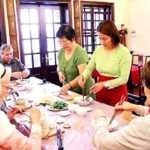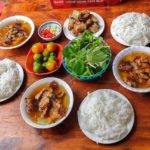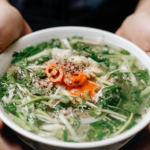When it comes to the cuisine of Hanoi, there is a wide selection of dishes to choose from. Many of these dishes are famous not only within Vietnam but also internationally.
Trang An’s delicacies are renowned for their ability to showcase the sophisticated tastes of the ancient Hanoians.
| The dish of Cha Nhai Khuong Thuong. Photo: Vu Vu |
The dish called Gio Goi Mo Cau is a traditional Vietnamese delicacy. It consists of pork bologna that is wrapped in areca spathe. This unique combination of flavors and textures makes it a popular dish in Vietnamese cuisine.
One of the renowned specialties is Uoc Le pork bologna, originating from the suburban district of Thanh Oai in Hanoi. A particular favorite is the grilled cinnamon bologna, known for its inviting golden color and delightful aroma. Other variations such as head cheese, pork skin sausage, and fat bologna are also popular choices. However, it is relatively rare to come across a piece of Gio Goi Mo Cau, or simply Gio Mo Cau.
Pork bologna, known as “gio” in Vietnamese, is a revered traditional dish wrapped in dried areca spathe, locally called “mo cau”. Its preparation is an age-old practice among suburban communities, particularly during festive occasions. This exquisite culinary creation is closely linked to Nhoi Village in Dong Anh District. Although several households in this area continue to craft this delicacy for numerous downtown vendors, its production is constrained by the limited availability of leaves.
The collection of areca tree leaves is a labor-intensive process as it can take several months for a leaf to naturally shed. To prepare these leaves for wrapping, they must be carefully gathered and cleaned. After drying, they are soaked in water to soften them. In some cases, individuals may choose to blanch the leaves before allowing them to drain.
The chosen meat consists mainly of lean pork leg, which is cut into medium-sized pieces. It is then combined with a small amount of pork cheek, ear, nose, and tongue to enhance its crispiness and stickiness.
|
Pork Bologna Wrapped In Areca Leaf is a unique and delicious delicacy from Hanoi. |
The meat is marinated and seasoned with ground pepper or peppercorns before being stir-fried. It is important to ensure that the meat is cooked properly, without overcooking, in order to maintain its pink color.
After the meat has been prepared, it is carefully placed inside a completed areca leaf. The leaf is then tightly rolled into a cylindrical shape and securely tied with bamboo strings. The meat is left to drain its excess fat by hanging it. After a period of one or two days, the meat is then ready to be sliced and enjoyed.
Introducing Gio Mo Cau, a distinctive variety of Vietnamese pork bologna. While it may appear similar to other types at first, there are notable differences that set it apart. Notably, it offers a drier texture and is less fatty, resulting in improved digestibility and a less overwhelming taste. What truly adds to its appeal is the unique preparation method – the casing is carefully sliced alongside the content and then removed, revealing a delicate white film of areca leaf. This delicate addition gives Gio Mo Cau a delightful aroma that enhances the overall experience.
Although Gio Mo Cau is a delectable dish, its scarcity is unfortunate due to the decrease in areca trees caused by urbanization around Hanoi. However, those fortunate enough to have tasted it will undoubtedly have a lasting memory.
Cha Nhai Khuong Thuong: Also known as Frog Cake, this delightful delicacy originates from Khuong Thuong Village.
| The special dish of Cha Nhai can be found today in Hanoi’s Khuong Thuong Ward, Dong Da District. Photo: Vy Le |
The region of Khuong Thuong was traditionally a fertile area primarily utilized for rice farming, resulting in a thriving population of snails and frogs. Inspired by this natural abundance, the locals became renowned for their delectable dish of snail rice vermicelli, known as “Cha Nhai,” which has gained recognition even among the residents of Hanoi.
The largest frogs are typically reserved for flour frying, while medium-size frogs are commonly used for cakes after removing the skin and organs. The frog meat and bones are minced and pounded to ensure a smooth consistency, before being combined with minced belly, raw pork paste, pepper, chili, spices, and chopped herbs.
The mixture is carefully kneaded into small, round shapes and fried in hot oil to perfection. The result should be a delightful golden-brown color, with a satisfying crispiness on both sides. However, the interior remains moist, ensuring that the distinctive fragrance and decadent sweetness of the frog meat are retained.
Today, if you are interested in tasting the delicious dish of cha nhai, you have the opportunity to visit Khuong Thuong Ward in Dong Da District. The rice fields surrounding Hanoi have been diminishing, making it more challenging to find frogs. Nevertheless, the cake remains an exceptional and must-try delicacy in the vibrant capital city.
Nem Oc Phap Van is a Vietnamese dish known for its deliciousness and unique flavors. Originating from Phap Van Village, these Snail Spring Rolls are a must-try for food enthusiasts. The combination of tender snails with fresh herbs and crispy spring roll wrappers creates a heavenly taste that will leave you wanting more. Don’t miss out on the opportunity to experience the incredible flavors of Nem Oc Phap Van!
| Hanoi’s specialty of nem oc or snail spring rolls.Photo: Quynh Vu |
Nem Oc stands out among its competitors, Gio Goi Mo Cau and Cha Nhai, due to its accessibility of the main ingredient – snails. For those searching for this delicacy, Google often directs them to Phu Dong Thien Vuong Street in downtown area. However, only a few are aware that the origins of these unique spring rolls can be traced back to Phap Van Village in Thanh Tri District, a secluded hamlet known for its primary agricultural produce of wet rice.
The snails are meticulously cleaned and then boiled with a combination of lime and lemongrass leaves. Timing is key, as once the water reaches a boil and the snails open their opercula, they are immediately removed to ensure their natural sweetness is preserved.
The ingredients are carefully prepared by marinating them in salt, lime juice, or vinegar to enhance their freshness and texture. The marinated ingredients, including meat, minced pork, raw pork paste, betel leaves, vermicelli, wood ear, and scallions, are then skillfully wrapped in delicate rice paper.
The spring rolls should be approximately the size of a thumb and fried at high heat for quick cooking and a crisp texture. These spring rolls, known as Nem Oc, can be served hot with rice vermicelli and accompanied by fresh herbs. They are commonly enjoyed when dipped in sweet and sour fish sauce, mayonnaise, or chili sauce.
In the context of international integration and multiculturalism, Hanoi delicacies such as Gio Goi Mo Cau, Cha Nhai Khuong Thuong, and Nem Oc Phap Van continue to be irresistible highlights on the capital’s culinary landscape. Despite the growing popularity of exotic foods from different parts of the world, these traditional dishes hold a special place that cannot be replaced.
Culinary space in the heart of Hanoi’s Old Quarter
NDO – Located on the second floor of house No.25 on Ma May Street, Hoan Kiem District, Anh Tuyet Restaurant is an elegant and warm space founded by a culinary artisan.













